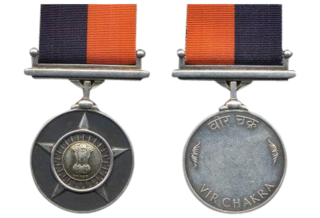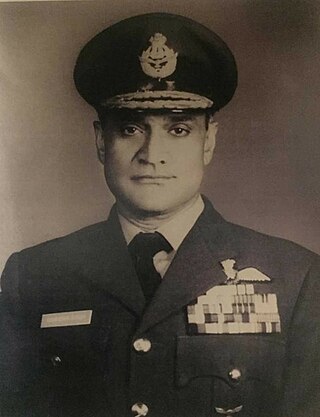
The Vir Chakra is an Indian wartime military bravery award presented for acts of gallantry on the battlefield, on land or in the air or at sea.

Flying Officer Nirmal Jit Singh Sekhon, PVC was an officer of the Indian Air Force. He was posthumously awarded the Param Vir Chakra, India's highest military decoration during war time, in recognition of his lone defence of Srinagar Air Base against a Pakistan Air Force (PAF) air raid during the Indo-Pakistani War of 1971. He is the only member of the Indian Air Force to be honoured with the PVC.
Wing Commander Trevor Keelor, VrC, VM was an officer of Indian Air Force who participated in the Indo-Pakistani War of 1965. He was honoured with a number of medals including the Vir Chakra and the Vayu Sena Medal. He had an elder brother, Denzil, who was also honoured for his service in the Indian Air Force. Both brothers have a Vir Chakra for the same feat of shooting down Pakistan Air Force F-86 Sabre fighters. It was the first time two brothers have received Vir Chakras for the same reason.
Flight Lieutenant Alfred Tyrone Cooke VrC is an Indian pilot who was decorated for his role in the Indo-Pakistani War of 1965. He was honoured with the Vir Chakra in September 1965. He received the award for shooting down a Sabre jet and severely damaging another, whilst flying a Hawker Hunter, whilst they were under anti-aircraft fire. It has been said that, "Flt Lt Alfred Tyrone Cooke is the only pilot in the Indian Air Force, who could claim to have engaged multiple enemy aircraft in the air and got the better of them."

Air Commodore Jasjit Singh, AVSM, VrC, VM was an Indian Air Force officer, writer and military strategist. In his military career, he was awarded the Vir Chakra during the Indo-Pakistani War of 1971. He last served as the Director of Operations of the IAF.

Air Marshal Man Mohan Sinha, PVSM, AVSM, VM, was an Indian Air Force officer and a veteran of the Indo-Pakistani War of 1965. He was honoured with a number of medals including the Param Vishist Seva Medal, the Ati Vishisht Seva Medal and the Vayusena Medal.
Squadron Leader Mandepanda Appachu Ganapathy was a fighter pilot and officer of the Indian Air Force, known for his involvement in the Aerial Battle of Boyra during the Indo-Pakistani War of 1971. He was awarded the Vir Chakra for shooting down a PAF Sabre in the above-mentioned aerial battle

Squadron Leader Ajjamada Boppayya Devayya MVC is the only Indian Air Force officer to be posthumously awarded the Maha Vir Chakra (MVC). The Maha Vir Chakra is the second highest wartime gallantry award, below only to the Param Vir Chakra. During the 1965 India-Pakistan War, Devayya was part of a strike mission targeting the Pakistani airbase Sargodha when he was attacked by an enemy aircraft. He shot down the enemy pursuer's plane but in the process his aircraft was damaged and he went missing. Presumably he died in Pakistani territory. Twenty-three years later, in 1988, he was posthumously awarded the MVC award.
Air Marshal Cheppudira Devaiah Subbaiah is a former pilot and officer in the Indian Air Force.

Air Chief Marshal Hrushikesh Moolgavkar, PVSM, MVC was a former Air officer in the Indian Air Force. He served as the 9th Chief of the Air Staff of the Indian Air Force from 1 February 1976 to 31 August 1978.
Air Marshal Vinod Patney, SYSM, PVSM, AVSM, VrC is a retired Indian Air Force officer. He is currently Director General Centre for Air Power Studies.
Wing Commander Padmanabha Gautam, MVC & Bar, VM was an officer in the Indian Air Force. He was awarded the India's second-highest war-time gallantry award, the Maha Vir Chakra twice. Awarded during the Indo-Pakistani War of 1965 and the Indo-Pakistani War of 1971, Gautam is one of only six officers to have been decorated with the Maha Vir Chakra twice.

Wing Commander Jag Mohan Nath, & bar was an Indian Air Force officer. He was the first of the six officers to have been decorated with the Maha Vir Chakra, India's second highest war time military decoration, twice. He was decorated for his operations in the Sino-Indian War of 1962 and Indo-Pakistani War of 1965.

Air Vice Marshal Chandan Singh, MVC, AVSM, VrC was an Air Officer in the Indian Air Force. A highly decorated officer, Singh was awarded the Vir Chakra during the Sino-Indian War and the Maha Vir Chakra during the Indo-Pakistani War of 1971.
Air Vice Marshal Cecil Vivian Parker, MVC, VM is a former air officer of the Indian Air Force. During the Indo-Pakistani War of 1971, he was awarded the Maha Vir Chakra, India's second highest military decoration. He last served as the Commandant of the Air Force Academy.

Group Captain Virendera Singh Pathania, VrC, VM, was an Indian Air Force (IAF) fighter pilot reputed for making the first confirmed aerial dogfight kill of independent India when he shot down a Pakistan Air Force (PAF) Sabre Jet with his Folland Gnat on 4 September 1965. For this action, he was awarded the Vir Chakra.

Wing Commander Amar Jit Singh Sandhu VrC, VM was an Indian Air Force officer and fighter pilot. He was awarded the Vir Chakra and the Vayusena Medals. He is credited with shooting down a Pakistan Air Force North American F-86 Sabre in the Indo-Pakistani War of 1965.
Wing Commander Vinod Kumar Neb VrC and Bar was a retired Officer and fighter pilot of the Indian Air Force and a hero of the Indo-Pakistani War of 1965 and Indo- Pakistan War of 1971. He was awarded with medals for bravery twice during his service. He was awarded the Vir Chakra twice for shooting down a Pakistan Air Force Sabres in each war in 1965 and 1971.









